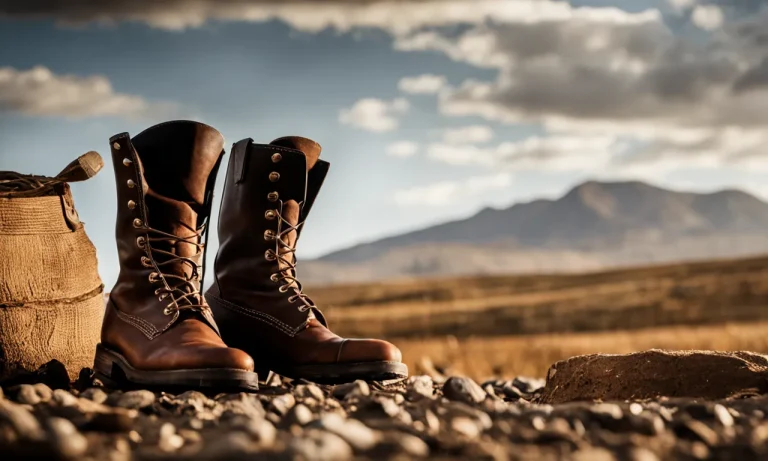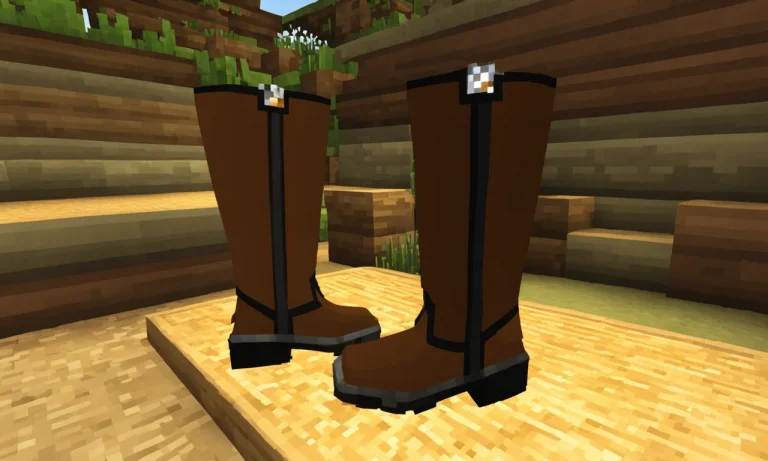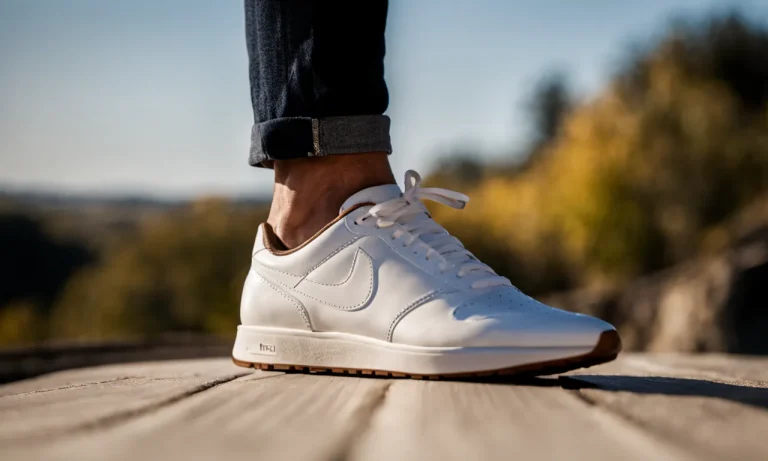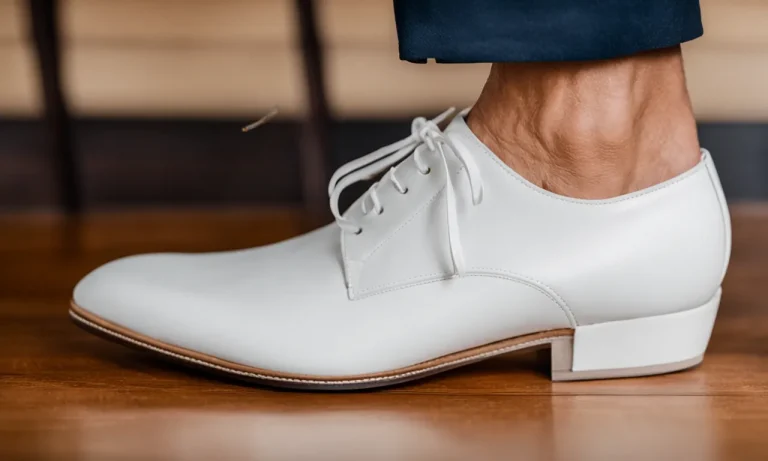Have you ever been walking down the street when suddenly the sole of your shoe starts flapping and comes clean off? A falling-off sole can ruin your day and leave you feeling frustrated. But don’t worry – with some detective work and simple repairs, you can get your sole firmly reattached to your shoe.
If you’re short on time, here’s a quick answer to your question: Loose stitching, worn tread, weak glue, and moisture damage are the main culprits when it comes to detached soles. You can often fix the issue with shoe glue or by restitching the sole.
Examining Potential Causes of a Detached Shoe Sole
Have you ever experienced the frustration of your shoe sole coming off? It can be incredibly annoying, not to mention a potential hazard. Understanding the causes behind this issue is essential to finding a solution.
Here, we will explore some common factors that can lead to a detached shoe sole and provide tips on how to fix it.
Loose Stitching
One possible cause of a detached shoe sole is loose stitching. Over time, the thread used to attach the sole to the upper part of the shoe may become worn or weakened. This can result in the sole separating from the shoe.
If you notice loose or frayed stitching around the edges of your shoe, it may be time to consider getting it repaired. A professional cobbler can re-stitch the sole securely, ensuring that it stays in place for longer.
Worn Tread
Another common culprit behind a detached shoe sole is worn tread. The tread on the bottom of the shoe provides traction and grip. However, with regular use, the tread can become worn down, making it easier for the sole to detach.
If you find that your shoe’s tread is significantly worn, it may be wise to invest in a new pair of shoes. Alternatively, you can have a cobbler replace the sole or add a protective layer to enhance durability.
Weak Glue
Weak glue is also a potential cause of a detached shoe sole. Sometimes, the adhesive used to attach the sole to the shoe is not strong enough or has deteriorated over time. This can result in the sole coming off with minimal force or wear.
If you suspect weak glue is the issue, you can try using a shoe repair adhesive or taking your shoes to a professional who can reattach the sole with a stronger adhesive.
Moisture Damage
Moisture damage is another factor that can lead to a detached shoe sole. Excessive exposure to water or humidity can weaken the bond between the sole and the shoe. If you frequently wear your shoes in wet conditions or fail to dry them properly after getting wet, the glue holding the sole in place may deteriorate.
To prevent this, it is essential to keep your shoes clean and dry, and consider using a waterproofing spray to protect them from moisture.
Remember, it is always a good idea to consult a professional cobbler if you are unsure how to fix a detached shoe sole. They have the expertise and tools necessary to address the issue effectively and ensure that your shoes are back in shape.
How to Repair a Shoe with a Detached Sole
Having the sole of your shoe come off can be frustrating, but fear not! There are several methods you can try to repair your shoe and get it back in working condition. Here are three common ways to fix a shoe with a detached sole:
Gluing the Sole
One of the simplest and most cost-effective ways to repair a detached sole is by using shoe glue. First, clean the area where the sole has detached from any dirt or debris. Then, apply a generous amount of shoe glue to both the sole and the shoe itself.
Press the two surfaces together firmly and hold them in place for a few minutes to ensure a secure bond. Let the glue dry completely before wearing the shoe again. This method works well for minor sole separations and can provide a quick fix.
Stitching the Sole
If your shoe has a more severe sole detachment or the glue method didn’t work, stitching the sole back in place may be a better option. You will need a needle and strong thread or nylon fishing line. Start by making small holes along the edge of the sole where it detached from the shoe.
Then, thread the needle and start stitching the sole back to the shoe, using a tight and secure stitch. Make sure to stitch through both the sole and the shoe material for maximum durability. Keep stitching until the entire sole is securely attached.
This method may require a bit more time and effort, but it can provide a long-lasting solution for your shoe.
Using Shoe Repair Shops
If you’re not confident in your own repair skills or if the sole detachment is too severe for DIY methods, taking your shoe to a professional shoe repair shop is a great option. Shoe repair shops have the expertise and specialized tools to fix all kinds of shoe problems, including detached soles.
They can use professional-grade adhesives or stitching techniques to ensure a strong and durable repair. While this option may require a higher cost, it can be worth it for shoes that are valuable or sentimental.
Remember, prevention is key when it comes to keeping your shoe soles intact. Regularly inspect your shoes for any signs of wear or loose soles, and address them promptly to prevent further damage. Taking proper care of your shoes, such as avoiding excessive moisture or rough terrain, can also help prolong their lifespan.
By following these repair methods and practicing good shoe maintenance, you can extend the life of your favorite pair of shoes and avoid the frustration of constantly dealing with detached soles.
Preventing Sole Separation in the Future
Dealing with a sole that keeps coming off your shoe can be frustrating and inconvenient. To avoid this issue in the future, there are several preventative measures you can take. By following these tips, you can keep your shoes intact and extend their lifespan.
Regularly Checking Stitching
One common cause of sole separation is weak or damaged stitching. Over time, the stitching on your shoes can wear out, leading to the sole detaching. To prevent this, it is important to regularly inspect the stitching on your shoes. Look for loose threads or any signs of fraying.
If you notice any issues, consider reinforcing the stitching or taking your shoes to a professional cobbler for repair. Taking proactive steps to strengthen the stitching can significantly reduce the risk of sole separation.
Replacing Worn Treads
Another factor that can contribute to sole separation is worn out treads. The treads on your shoes provide traction and support, and when they become worn down, it can weaken the bond between the sole and the upper part of the shoe.
To prevent this, make sure to regularly check the condition of the treads on your shoes. If you notice significant wear or smoothness on the treads, it may be time to replace them. This simple maintenance step can help to prevent sole separation and ensure the longevity of your shoes.
Weatherproofing
Exposure to moisture, such as rain or snow, can weaken the adhesive that holds the sole to the shoe. To protect your shoes from the elements, consider applying a weatherproofing product. These products create a barrier that repels water and helps to maintain the integrity of the adhesive.
Be sure to follow the instructions provided with the weatherproofing product and apply it regularly, especially before wearing your shoes in wet conditions. By keeping your shoes protected from moisture, you can reduce the risk of sole separation.
Rotating Shoes
Wearing the same pair of shoes every day can put excessive stress on the soles and accelerate wear and tear. To prevent sole separation, consider rotating your shoes. By alternating between different pairs, you allow the soles to rest and recover, reducing the chances of them detaching.
Additionally, rotating shoes can help to distribute wear more evenly and extend the overall lifespan of your footwear. It’s a simple habit that can make a big difference in preventing sole separation.
By implementing these preventative measures, you can minimize the chances of experiencing sole separation in the future. Remember to regularly check the stitching, replace worn treads, weatherproof your shoes, and rotate them.
Taking care of your shoes will not only save you from the frustration of dealing with detached soles but also save you money in the long run by extending the life of your footwear.
Conclusion
Having to stop and deal with a sole falling off your shoe can be a nuisance, but don’t despair. With some DIY repair techniques and preventative care, you can get many more miles out of your footwear. Just be sure to periodically inspect your shoes’ soles, re-glue when needed, and consider stitching for a stronger hold.
Your soles will stay firmly attached to your shoes so you can continue on your way in comfort.






